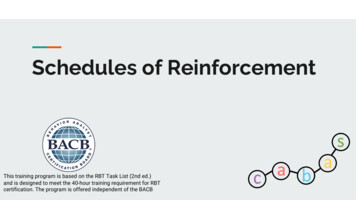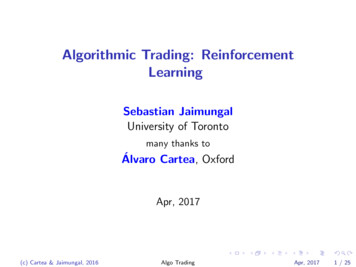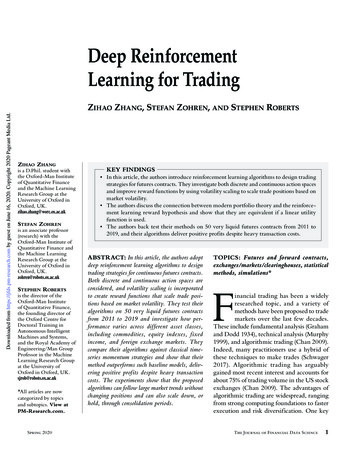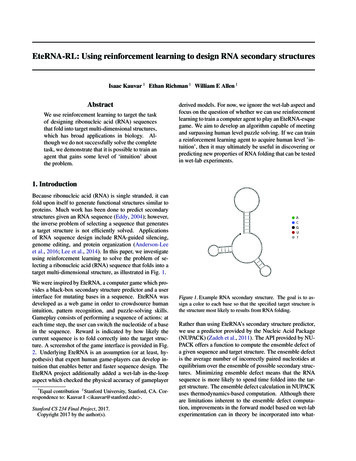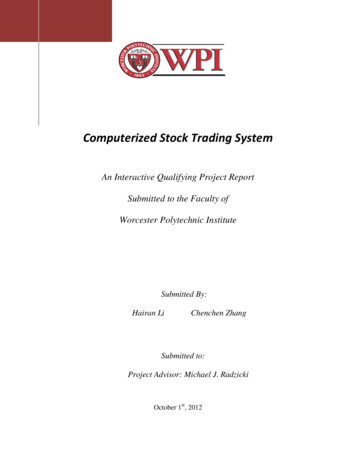
Transcription
Reinforcement Learning for FX tradingYuqin Dai, Chris Wang, Iris Wang, Yilun Xu
A brief intro to our strategy.
RL Strategy on High-frequency Forex (1/2)How is Forex traditionally traded?- A few key decisions:- Currency pair to trade- Position size- When to enter/exit- Which dealer to use/how to execute the trade- Bid-ask spread-Traditional strategies use Momentum, Mean Reversion, Pivots, FundamentalStrategy, Stop-loss orders- Trend-based - machine learning?- Scalping, Day trading, Longer time frames
RL Strategy on High-frequency Forex (2/2)Reinforcement learning for forex trading- Reinforcement Learning (RL) is a type of machine learning technique that enables an agent tolearn in an interactive environment by trial and error using feedback from its own actions andexperiences.- Trading is an “iterative” process, and past decisions affect future, long-term rewards in indirectways- Compared to supervised learning, we are not making or losing money at a single time step - Traditional “up/down” prediction models do not provide an actionable trading strategy- Incorporate longer time horizon- Give us more autonomy in trading policy, regularize the model from trading too frequently
Since midterm presentation. A larger dataset: 6 days - 1 month (25 trading days) We found a data processing bug in our previous result, which indicates ourprevious PnL result is no longer valid More models: linear direct RL - deep direct RL and DQN More currency pairs: AUDUSD - AUDUSD, EURUSD, GBPUSD Hyperparameter tuning and error analysis Migrate to cloud
Data Processing and Training PipelineData Processing--Clean raw dataset and sample itinto a second-level onePad the data for each liquidityprovider to the same time frameBuild an order book by picking thebest bid/ask pricesExtract features using bid/ask/midprice returns from all 8 currencypairsTrain one target currency at a timeChoose model structure based onAUDUSD while train the samemodel for EURUSD and GBPUSDTraining PipelineAUDUSD, EURUSD, GBPUSD
Deep direct reinforcement learning model.
Deep Direct RL Model (1/2)GoalMaximize total (undiscounted) return over 1-hour horizon by making short/long tradingdecisions for target currency per secondInputPer second bid-ask prices for target currency and other available currency pairs; include therecent 16-second returns as featuresActionFloat between -1 (short the currency with all cash) and 1 (long the currency with all cash)MethodPolicy Gradient Maximize the “expected” reward when following a policy π Actions are chosen by ‘actor’, i.e. mapping current features to next action Gradient descent on π to find the optima
Deep Direct RL Model (2/2)In detailRewards incorporating bid-ask d[t]Bid[t]0
Hyperparameter Tuning and ExperimentationEval Reward, epoch 20AdamSGD Number of FeaturesEval Reward, epoch 20256 Number of hidden layersEval Reward, epoch 20(64, 8) (50, 50)512BiasEval Reward, epoch 20Bias in last layer No bias in last layerReward with dropout vs no dropout
Hyperparameter Analysis Dropout Prevents our model from overfitting as the epoch number increasesNumber of features Too many features can be harmful because they impart noise and make itharder for the model to convergeBias An additional parameter in the last layer can be helpful in allowing the modelto learn new relationshipsNumber of hidden layers The number of hidden layers should decrease graduallyAdam vs. SGD Adam is faster at first in learning, but SGD generalizes better long-term
Result Analysis: AUDUSD (1/2)Deep Direct Reinforcement Learning model performance on eval set12 hours’ trainingBreakeven per hour with per AUD1,000 initial capitalYield 0.000%12 hours’ trainingBreakeven per hour with per AUD1,000 initial capitalYield 0.000%12 hours’ trainingLose USD 1.03 per hour with perAUD 1,000 initial capitalYield -0.147%
Result Analysis: AUDUSD (2/2)Deep Direct Reinforcement Learning model performance on eval & test setLose USD 0.25 per hour with perAUD 1,000 initial capital, with stdof USD 1.745Yield -0.036%Breakeven per hour with per AUD1,000 initial capital, with std of USD0.811Yield 0.000%Lose USD 0.12 per hour with perAUD 1,000 initial capital, with stdof USD 4.06Yield -0.017%
Result Analysis: EURUSD (1/2)Deep Direct Reinforcement Learning model performance on eval set12 hours’ trainingGain USD 0.62 per hour with perEUR 1,000 initial capitalYield 0.055%12 hours’ trainingGain USD 0.87 per hour with perEUR 1,000 initial capitalYield 0.078%12 hours’ trainingLose USD 0.63 per hour with perEUR 1,000 initial capitalYield -0.056%
Result Analysis: EURUSD (2/2)Deep Direct Reinforcement Learning model performance on eval & test setGain USD 0.18 per hour with perEUR 1,000 initial capital, with std ofUSD 2.758Yield 0.014%Gain USD 0.30 per hour with perGain USD 0.69 per hour with perEUR 1,000 initial capital, with std of EUR 1,000 initial capital, with std ofUSD 2.593USD 7.291Yield 0.023%Yield 0.052%
Result Analysis: GBPUSD (1/2)Deep Direct Reinforcement Learning model performance on eval set12 hours’ trainingLose USD 0.55 per hour with perGBP 1,000 initial capitalYield -0.044%12 hours’ trainingBreakeven per hour with per GBP1,000 initial capitalYield 0.000%12 hours’ trainingLose USD 0.74 per hour with perEUR 1,000 initial capitalYield -0.058%
Result Analysis: GBPUSD (2/2)Deep Direct Reinforcement Learning model performance on eval & test setLose USD 0.21 per hour with perGBP 1,000 initial capital, with stdof USD 1.589Yield -0.016%Gain USD 0.072 per hour with perGBP 1,000 initial capital, with stdof USD 1.298Yield 0.0056%Lose USD 0.413 per hour with perGBP 1,000 initial capital, with stdof USD 1.478Yield -0.032%
Across-time/ Currency Analysis (1/2)Deep Direct Reinforcement Learning model performance on lag dataGBPUSD model trained on train week 1and tested on eval week 2GBPUSD model trained on train week 1and tested on eval week 3
Across-Time/ Currency Analysis (2/2)Deep Direct Reinforcement Learning model gradient w.r.t. first 32 featuresGBPUSD model gradients on eval week 1GBPUSD model gradients on eval week 1,2 and 3Deep DRL model keeps looking for the same “patterns” across different time horizons
Deep Q-Network RL model.
Deep Q-Network Model (1/3)GoalEstimate long-term discounted state-action pair values by Q network, and train an optimalpolicy based on the estimationInputPer second bid-ask prices for target currency and mid price of other available currency pairs;include the recent 16-second log returns, timestamp and previous position as features;Action-1 (short), 0 (neutral) or 1 (long)Method
Deep Q-Network Model (2/3)
Deep Q-Network Model (3/3)Customize 1: environment Self-defined environment which can draw training data point (bid-ask price with features) inorder, without leaking the future priceCustomize 2: memory replay Choose a small buffer size to conduct memory replay, which incorporates our belief thatthe most recent data points are more relevant in the marketCustomize 3: exploration strategy Use standard epsilon greedy to encourage exploration during policy training Furthermore, use action augmentation to encourage deep exploration. For example, ourpolicy chooses action 1 at time step t, with reward r. Then we add (s, 1, r), (s, -1, r) and (s,0, 0) to the buffer
Result Analysis: AUDUSD (1/2)Deep Q-Network Reinforcement Learning model performanceRunning loss of the model decreases monotonically, while the training and eval reward fail toincrease over time, accordingly
Result Analysis: AUDUSD (2/2)Test result RL Agent learns to take neutral positions only (action 0) and breaks even on the test setConclusion and explanation Running loss decreases monotonically while training and eval reward diverge- The Q-Network can successfully model the infinite discounted state-action value- The Q-Network may not represent 1-hour trading returns well- Epsilon greedy action augmentation are not sufficient to train the optimal policy Agent decides to make almost no trade on test set- Limited flexibility: we only allow the agent to choose from {-1, 0, 1}- Confusing signals: we give a bunch of signals to the model without delicate featureengineering. The agent may learn to keep neutral only after seeing large amount ofdata points with close features
Our key takeaways.
Conclusions Why Forex RL trading works- trend-based; resembles factor model DRL vs. DQN- DRL is more interesting to explore Out-of-sample performance varies with time periods- performs the best when test period is 1 week after training period Performance largely depends on feature selection- 16 features perform better than 32 Deep models work better- able to capture more complex inter-feature relations
Potential Next Steps Incorporate better features- Feature engineering (e.g. Time-series analysis) Build a better architecture- Add residual blocks- LSTM More Training and Hyperparameter tuning- Train with data of a longer time span- Regularization, optimizer Add an Online Learning Scheme- Update with incoming data
Thank you for listening!Any questions?Thank you!
Reference1.Y. Deng, F. Bao, Y. Kong, Z. Ren and Q. Dai, "Deep Direct Reinforcement Learning for FinancialSignal Representation and Trading," in IEEE Transactions on Neural Networks and LearningSystems, vol. 28, no. 3, pp. 653-664, March 2017.2.Huang, Chien Yi. "Financial Trading as a Game: A Deep Reinforcement Learning Approach." arXivpreprint arXiv:1807.02787 (2018).3.J. Moody and M. Saffell, "Learning to trade via direct reinforcement," in IEEE Transactions onNeural Networks, vol. 12, no. 4, pp. 875-889, July 2001.
Reinforcement learning for forex trading - Reinforcement Learning (RL) is a type of machine learning technique that enables an agent to . Why Forex RL trading works - trend-based; resembles fact

